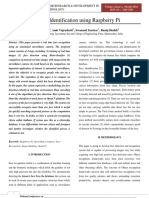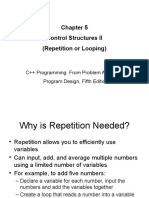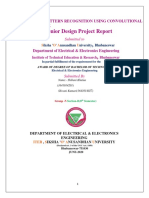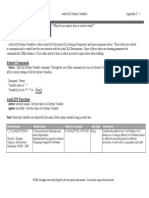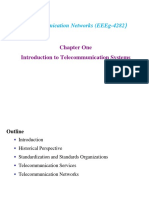EAI Endorsed Transactions: Smart Attendance System Using Face Recognition
EAI Endorsed Transactions: Smart Attendance System Using Face Recognition
Uploaded by
tanay.22110696Copyright:
Available Formats
EAI Endorsed Transactions: Smart Attendance System Using Face Recognition
EAI Endorsed Transactions: Smart Attendance System Using Face Recognition
Uploaded by
tanay.22110696Original Title
Copyright
Available Formats
Share this document
Did you find this document useful?
Is this content inappropriate?
Copyright:
Available Formats
EAI Endorsed Transactions: Smart Attendance System Using Face Recognition
EAI Endorsed Transactions: Smart Attendance System Using Face Recognition
Uploaded by
tanay.22110696Copyright:
Available Formats
EAI Endorsed Transactions
on Scalable Information Systems Research Article
Smart Attendance System using Face Recognition
Jayaraj Viswanathan1,*, Kuralamudhan E2, Navaneethan S3 and Veluchamy S4
1,2,3,4
Department of Computer Science and Engineering, Amrita Vishwa Vidyapeetham, Chennai, India
Abstract
Face recognition offers a wide range of valuable applications in social media, security, and surveillance contexts. The
software used for building facial recognition algorithms is Python and OpenCV. "Attendance using Face Recognition" is a
method for tracking and managing attendance that makes use of facial recognition technology. By seamlessly integrating
the 'Face Recognition' module, a native Python feature, and the OpenCV library, our system excels in accuracy and
dependability. The system then stores attendance records in a database and provides real-time reports. In this article, we
demonstrate how to create a face recognition system in Python utilizing the built-in "Face Recognition" module and the
OpenCV library. Our results show that our system achieves high accuracy and robustness while being efficient and
scalable, catering to a wide spectrum of educational institutions, organizations, and enterprises.
Keywords: Computer Vision, machine learning, face recognition, Open CV, facial feature extraction
Received on 30 November 2023, accepted on 19 February 2024, published on 26 February 2024
Copyright © 2024 Jayaraj Viswanathan et al., licensed to EAI. This is an open access article distributed under the terms of the CC
BY-NC-SA 4.0, which permits copying, redistributing, remixing, transformation, and building upon the material in any medium so
long as the original work is properly cited.
doi: 10.4108/eetsis.5203
Corresponding author. Email: ch.en.u4cys21026@ch.students.amrita.edu
*
easy way to keep track of people and manage their
attendance [3]. This implementation offers a more efficient
1. Introduction and accurate way to manage attendance records compared to
other traditional methods such as paper-based systems or
Face recognition has gotten a part of consideration due to its manual data entry.
convenience in numerous diverse areas. It includes
identifying and recognizing people from facial pictures or The primary achievements of this endeavour are outlined as
recordings [1]. In computer vision and machine learning, follows:
face recognition has grown in popularity, and numerous 1. Creation of an independent attendance management
algorithms have been created over time [2]. The main idea is system which depends on detecting facial features
to naturally distinguish or confirm a person based on their present within human faces.
facial highlights. Python and OpenCV are popular tools for 2. Demonstration of facial feature extraction within group
implementing face recognition algorithms, with many
settings as a focal point of this study.
libraries and modules available for use. Using facial
3. Implementation of the complete operational model in
recognition technology, "Attendance using Face
Recognition" is a system created to make the procedure of the form of a web application, ensuring straightforward
recording attendance automatic. A camera is used by the accessibility.
model to capture images of people entering specific
locations, their identities are then verified and processed 1.1 Disadvantages of Manual Attendance
using deep learning algorithms.
System
The model stores the attendance records in a database to
provide real time reports to the administrators. It provides an
EAI Endorsed Transactions on
Scalable Information Systems
1 Online First
J. Viswanathan et al.
Manual attendance systems have several drawbacks. Firstly, A deep neural network and set-based face recognition
they are time-consuming as it requires employees to sign in method was proposed by Prathama et al [7]. since ageing
and out which causes delays. Secondly, they are error-prone, alters facial features and affects recognition. They regard
with issues like misreading handwriting and discrepancy in each subject's collection of photographs captured at various
recording attendance at times lead inaccuracies [4]. Lastly, points in time as a single set and contrast it with collections
these systems raise security concerns, as they are vulnerable of images of other subjects. It has been discovered that set-
to fraud and manipulation by employees, resulting in based recognition outperforms singleton-based recognition
inaccurate attendance records. This can impact financial and for both identification and verification, and that utilizing set-
tracking processes. based recognition, it is simpler to distinguish between older
and younger people.
A novel approach to facial recognition incorporating
1.1 Benefits of Smart Attendance System advanced feature extraction techniques was proposed by
Husein et al [8]. The system uses the OpenCV cascade
Implementing face recognition technology for attendance classifier to detect faces and the distinctive characteristics
tracking comes with several advantages. Firstly, it extracted from the set of facial data to distinguish between
significantly saves time by automatically identifying the facial images. The authors also assess the android
individuals and recording their attendance thereby device's battery life, processor power, and memory usage.
eliminating the need for manual processes and paperwork. The results demonstrate 93% accuracy in favourable
Secondly, it enhances accuracy by minimizing the lighting. The paper concludes by discussing the benefits and
likelihood of errors in attendance records. Moreover, this limitations of face recognition in android.
technology provides real-time attendance data allowing Facial Recognition for Attendance and Management by
administrators to make quick decisions related to staffing, Baskar et al [9]
scheduling, or absenteeism [5]. Additionally, it bolsters proposed a facial identification and recognition system to
security measures, as it is difficult to impersonate someone automate attendance records in classrooms. The system
else's face, reducing the risk of fraudulent attendance involved an enrolment process, recognition, and
entries. In summary, adopting face recognition for authentication procedures. They used machine learning
attendance offers improved precision, time efficiency, real- models and classifiers to identify and label faces, and record
time insights, and heightened security compared to attendance accordingly. The paper concludes with the
traditional manual systems. implementation results and areas for improvement.
Udit’s "Image Processing Using OpenCV" [10] This
study investigated the application of OpenCV, a free
2. Literature Survey computer vision toolkit, to image processing tasks. The
paper provides an overview of OpenCV and its features,
Face Recognition System Technology by Sagar et al [6]
including its ability to handle real-time image processing,
discussed biometric and face recognition as a domain that
detect and track objects, and recognize faces.
begins with face detection and extraction of features. It
Face Recognition by Sudhir et al [11] is the foundation
explained the scope and benefits of the project along with
of the Smart Attendance System utilising OpenCV. This
related works and challenges in face recognition due to
research study described a system for automating classroom
limited datasets. It concludes that face recognition is an
attendance using OpenCV and facial recognition methods.
emerging technology that will only become more accurate
The study laid out the need for a mechanized participation
and efficient.
framework which reduces errors and saves time compared to
the traditional manual frameworks.
Figure 1. Block diagram describing the design of our algorithm for face recognition
EAI Endorsed Transactions on
Scalable Information Systems
2 Online First
Smart Attendance System using Face Recognition
by first converting the real-time image from "BGR"
3. Proposed Methodology to "RGB" format and then saving them in pairs.
4. Face Recognition: After that, the facial features are
analysed, and if they match those in our dataset,
3.1. Existing Practice attendance is noted in the excel sheet along with the
date and hour.
The existing practice for taking attendance can vary
depending on the specific setting and purpose. Typical
actions include the following: 4. Results
1. Sign-in sheet: In this method, the instructor or teacher
provides a sheet of paper with the names of the
students and asks them to sign in when they arrive 4.1. Dataset and Environmental setup
[12].
2. Roll Call: This is the traditional method where the In this work, a dataset comprising 16 human face images
instructor or teacher calls out each student's name and was utilized. These images were obtained from students
and teachers affiliated with Amrita Vishwa
the student respond with "present" or "here".
Vidyapeetham, showcasing a diverse range of facial
3. Barcode/RFID scanning: Some institutions use
expressions. These images serve as the dataset for training
technology such as barcode or radio-frequency and evaluating our face recognition system [Figure 2].
identification (RFID) scanners to track attendance The images were originally in JPEG and JPG formats
[13]. and possessed a resolution of 1209 x 1620 pixels, as
4. Participation-based: In some courses, attendance may depicted in Figure 2. Subsequently, the images were pre-
be taken based on participation. This means that processed by cropping them to isolate the facial area and
students need to actively participate in the class resizing them to a consistent size. This resizing ensured
discussion, group work, or other activities to be that the resulting output images were one-fourth the width
counted as present [14]. and height of the original input images.
5. Peer Check-in: In this method, students may be asked
to check in with a classmate or group to confirm their
attendance [15][16].
Most of these approaches are subject to errors, Time
consuming and are not 100% reliable thus a need for a
better solution to taking attendance is necessary in the
near future.
Figure 2. Sample images collected from students
3.2. Proposed Method
Figure 1 illustrates the proposed method which involves
the following steps:
1. Face Detection: To detect facial features in the given
input stream, we employ the "Face Recognition"
module in Python. In order to find faces, the module
makes use of a trained model. The image of the
person is loaded using “load_image_file” method and
the detected faces are then passed to the next step for
alignment.
2. Face Alignment and Feature Extraction: The
face_encodings approach, which uses the popular Figure 3.1 Real-time face capture and recognition
“FaceNet” algorithm to find the lineaments and to
extract the facial features. The detected features are
then used get the facial coordinates which are then The experiment and implementation were conducted
stored as an array. using a Python language framework using Intel Core i7 |
3. Real Time Face Detection: For real time detection we 16 GB RAM. The Flask application was utilized to load a
use CV2 where cap.read()command is used to capture real-time video feed, where users were expected to
display their faces. The captured face in real time is
a frame from the video. The face_recognition library
compared with the pre-existing dataset using advanced
facilitates the extraction and storage of facial features
face recognition algorithms. The system matches the
facial features and accurately recognizes the individual
EAI Endorsed Transactions on
Scalable Information Systems
3 Online First
J. Viswanathan et al.
[Figure 3.1] [Figure 3.2]. Upon successful face
recognition, attendance was recorded in an Excel sheet,
including the individual's name, attendance time, and
status [Figure 4].
The evaluation of the attendance solution presented in
this research relies on the accuracy and face Match Index.
The dataset used for training and testing the system
comprises a very small number of images, resulting in a
relatively low accuracy of the model, with a maximum of
70%. The accuracy of the facial recognition system is
determined by calculating the minimum difference
between the facial highlights of the captured image and
the images in our dataset. The confusion matrix for the
proposed model shows that the model is accountable
[Figure 5].
Figure 4 Recorded attendance stored in an Excel
file
Figure 3.2 Face recognition of images downloaded
from the internet
EAI Endorsed Transactions on
Scalable Information Systems
4 Online First
Smart Attendance System using Face Recognition
Figure 5 Confusion matrix for the proposed model
[2] Lu J, Liong VE, Zhou J. Face Recognition using Local
5. Conclusion and Future Work Quantized Patterns. Proceedings of the 2012 IEEE
Conference on Computer Vision and Pattern Recognition
This study revolves around the creation of an autonomous (CVPR); 2012; Providence, RI, USA. p. 3562-3569.
attendance system that relies on facial characteristics. The [3] Dey AC, Ghosh SB. Improving Attendance Management
process commences with the detection of facial regions within in Educational Institutions using Face Recognition. In:
the input image, followed by the extraction of pertinent facial Proceedings of the International Conference on Machine
data using a Python-based face recognition library. The acquired Learning and Computer Vision; 2014. p. 345-350.
facial data is subsequently input into a CNN model for [4] Blanz V, Vetter T. Face Recognition Based on Fitting a 3D
classification. The experimental result shows that the developed Morphable Model. IEEE Transactions on Pattern Analysis
model exhibits superior performance, even in a group of people and Machine Intelligence. 2003; 25(9):1063-1074.
environment. Future work will delve into assessing the system's [5] Martinez AM, Benavente R. The AR face database. CVC
performance using pretrained models and incorporating Technical Report. 1998.
optimization techniques based on metaheuristics. [6] Deshmukh S, Rawat S. Face Recognition Technology.
Journal of Intelligent Computing. 2023; 120:39-52.
[7] Prathama V, Thippeswamy T. Age Invariant Face
Recognition. Journal of Intelligent Computing. 2023;
References 120:53-68.
[8] Mais Mohamed Husein, Alzubaydi D. Mobile Face
[1] Hui J, Tang S, Hu S. Face Recognition Based on
Recognition Application using Eigen Face Approach for
Convolutional Neural Networks and Softmax Regression.
Android. Journal of Mobile Applications. 2021; 5(2):45-
Proceedings of the 2017 International Conference on
56.
Image, Vision, and Computing (ICIVC), Chengdu, China.
2017; 112(116).
EAI Endorsed Transactions on
Scalable Information Systems
5 Online First
J. Viswanathan et al.
[9] Bhaskar J, Venkatesh V. Face Recognition for Attendance
Management. Journal of Intelligent Computing. 2023;
120:25-38.
[10] Malik U. Image Processing using OpenCV. Journal of
Computer Vision and Image Processing. 2020; 3(1):15-28.
[11] Bussa S, Mani A, Bharuka S. Smart Attendance System
using OpenCV based on Face Recognition. Journal of
Intelligent Computing. 2023; 120:83-96.
[12] Minaee S, Abdolshah S, Khademi Kalantari N. Deep
learning-based face recognition: A survey. Pattern
Recognition. 2020; 107.
[13] Ramya N, Manasa D, Naveed SK. Face Recognition for
Automated Attendance Management. Journal of Intelligent
Computing. 2023; 120:69-82.
[14] Lyon DM, Fisher JW. Multimodal Person Recognition
Using Unconstrained Audio and Video. Proceedings of the
5th IEEE International Conference on Automatic Face and
Gesture Recognition; 2002. p. 293-298.
[15] Veluchamy S, Michael Mahesh K, Pon Bharathi A, Paul T
Sheeba. DeepDrive: A braking decision-making approach
using optimized GAN and Deep CNN for advanced driver
assistance systems. Engineering Applications of Artificial
Intelligence. 2023; 123(A):106111. ISSN 0952-1976.
[16] Veluchamy S, Michael Mahesh K, Muthukrishnan R,
Karthi S. HY-LSTM: A new time series deep learning
architecture for estimation of pedestrian time to cross in
advanced driver assistance system. Journal of Visual
Communication and Image Representation. 2023;
97:103982. ISSN 1047-3203.
EAI Endorsed Transactions on
Scalable Information Systems
6 Online First
You might also like
- Final Project WorkDocument58 pagesFinal Project WorkToniaclara Xdacom50% (2)
- Face Recognition Based Automated Attendance Management SystemDocument10 pagesFace Recognition Based Automated Attendance Management SystemShilpa ReddyNo ratings yet
- Facial Recognition-Based Attendance SystemDocument7 pagesFacial Recognition-Based Attendance SystemInternational Journal of Innovative Science and Research TechnologyNo ratings yet
- Research - Paper Capstone ProjectDocument4 pagesResearch - Paper Capstone ProjectParikshit sharmaNo ratings yet
- Face Recognition Based Attendance Management SystemDocument5 pagesFace Recognition Based Attendance Management SystemIJRASETPublicationsNo ratings yet
- IJERTPaper On Facial Recognition Based Attendance SystemDocument6 pagesIJERTPaper On Facial Recognition Based Attendance SystemMohd.Imthiyas babuNo ratings yet
- Ijirt162129 PaperDocument6 pagesIjirt162129 PaperlinturimwendaNo ratings yet
- Face Recognition Based Attendance System Using Deep Learning TechniquesDocument8 pagesFace Recognition Based Attendance System Using Deep Learning Techniquesgregorio eulinNo ratings yet
- Facetrack Attendance System - Formatted PaperDocument10 pagesFacetrack Attendance System - Formatted Paperamitavakar98No ratings yet
- Paper 179Document6 pagesPaper 179pallaviakkaladeviNo ratings yet
- EN19EL301070 FaceRecognitionDocument6 pagesEN19EL301070 FaceRecognitionTuyền Lê ChíNo ratings yet
- Irjet V10i822Document5 pagesIrjet V10i822dk singhNo ratings yet
- Criminal Face Recognition Using Raspberry PiDocument3 pagesCriminal Face Recognition Using Raspberry Pirock starNo ratings yet
- Automatic Attendance Management System Using Face Recognition PDFDocument5 pagesAutomatic Attendance Management System Using Face Recognition PDFJDNET TECHNOLOGIESNo ratings yet
- Face Detection Based Attendance System Using Open CV ApproachDocument5 pagesFace Detection Based Attendance System Using Open CV ApproachInternational Journal of Innovative Science and Research TechnologyNo ratings yet
- IJRPR23389Document8 pagesIJRPR23389nithin71111No ratings yet
- Automatic Face Recognition Attendance System Using Python and OpenCvDocument7 pagesAutomatic Face Recognition Attendance System Using Python and OpenCvGRD Journals100% (1)
- Automatic Face Recognition Attendance System Using Python and OpencvDocument7 pagesAutomatic Face Recognition Attendance System Using Python and Opencvtanay.22110696No ratings yet
- Attendance Management System Using Face RecognitionDocument7 pagesAttendance Management System Using Face RecognitionIAES IJAINo ratings yet
- FR 4Document8 pagesFR 4osinoluwatosinNo ratings yet
- Automated Student Attendance Management System Using Face RecognitionDocument8 pagesAutomated Student Attendance Management System Using Face RecognitionDebolina RoyNo ratings yet
- Smart Attendance System: Using Facial Recognition TechnologyDocument6 pagesSmart Attendance System: Using Facial Recognition TechnologyhuxleighaidenNo ratings yet
- Face Recognition Based Attendance System With Auto Alert To Guardian Using Call and SMSDocument3 pagesFace Recognition Based Attendance System With Auto Alert To Guardian Using Call and SMSEditor IJTSRDNo ratings yet
- Present-Ma'Am An Attendance Management SystemDocument8 pagesPresent-Ma'Am An Attendance Management SystemIJRASETPublicationsNo ratings yet
- Real Time Face Attendance System Using Deep LearningDocument7 pagesReal Time Face Attendance System Using Deep LearningInternational Journal of Innovative Science and Research TechnologyNo ratings yet
- Project SynopsisDocument6 pagesProject SynopsisSourabh kumar mahatoNo ratings yet
- FACIALRECOGNITION-BASEDATTENDANCESYSTEMDocument8 pagesFACIALRECOGNITION-BASEDATTENDANCESYSTEMrishimaurya893No ratings yet
- Facialrecognition Basedattendancesystem (Paper 3)Document8 pagesFacialrecognition Basedattendancesystem (Paper 3)pradhanpratiksha19No ratings yet
- Real Time Implementation of Face Recognition Based Smart Attendance SystemDocument12 pagesReal Time Implementation of Face Recognition Based Smart Attendance Systemtanay.22110696No ratings yet
- Efficient Management SystemDocument3 pagesEfficient Management SystemtufanNo ratings yet
- Automation Attendance Systems Approaches: A Practical ReviewDocument9 pagesAutomation Attendance Systems Approaches: A Practical ReviewBOHR International Journal of Internet of Things ResearchNo ratings yet
- Research Paper - AttendeaseDocument13 pagesResearch Paper - AttendeasechomusussuNo ratings yet
- IRJET V4I1286 With Cover Page v2Document6 pagesIRJET V4I1286 With Cover Page v2Usha ParmarNo ratings yet
- Face Recognition Attendence System - A SurveyDocument6 pagesFace Recognition Attendence System - A SurveyInternational Journal of Innovative Science and Research TechnologyNo ratings yet
- Ijsrp-P14508 (1) Paper4Document19 pagesIjsrp-P14508 (1) Paper4pradhanpratiksha19No ratings yet
- Iilo Project Synopsis .46Document5 pagesIilo Project Synopsis .46laxmanchaudhary15270No ratings yet
- Dare's Project Proposal NewDocument5 pagesDare's Project Proposal NewOwolabi PetersNo ratings yet
- Auto Attendance SystemDocument7 pagesAuto Attendance SystemIJRASETPublicationsNo ratings yet
- Real Time Web-Based Smart Attendance System Using AIDocument4 pagesReal Time Web-Based Smart Attendance System Using AIIJARSCT JournalNo ratings yet
- Face Recognition Based Automated Student Attendance SystemDocument4 pagesFace Recognition Based Automated Student Attendance SystemEditor IJTSRDNo ratings yet
- CGV Cbs ReportDocument10 pagesCGV Cbs ReportPrathy ushaNo ratings yet
- Face Recognition Attendance Management SystemDocument4 pagesFace Recognition Attendance Management Systemmemoona.zulfiqar121No ratings yet
- Face Recognition Enhancement Systembyusing Parallel ProcessingDocument9 pagesFace Recognition Enhancement Systembyusing Parallel Processingnastaran.jahanbin27No ratings yet
- Face Recognition Based Smart Attendance System Using IOTDocument8 pagesFace Recognition Based Smart Attendance System Using IOTjohnjeffersonmamuad22No ratings yet
- Auto AttendenceDocument6 pagesAuto AttendenceMohd.Imthiyas babuNo ratings yet
- Synopsis FinalDocument10 pagesSynopsis FinalankuhsNo ratings yet
- Criminal Identification Using Raspberry Pi: Vivek Kalaskar, Amit Vajrashetti, Swanand Zarekar, Ramij ShaikhDocument3 pagesCriminal Identification Using Raspberry Pi: Vivek Kalaskar, Amit Vajrashetti, Swanand Zarekar, Ramij Shaikhrock starNo ratings yet
- Project Report On Attendance System Using Face RecognitionDocument40 pagesProject Report On Attendance System Using Face RecognitionMohammed YaseenNo ratings yet
- Face Recognition Based Attendance SystemDocument3 pagesFace Recognition Based Attendance SystemInternational Journal of Innovative Science and Research TechnologyNo ratings yet
- Criminal Identification Using Raspberry Pi: Vivek Kalaskar, Amit Vajrashetti, Swanand Zarekar, Ramij ShaikhDocument3 pagesCriminal Identification Using Raspberry Pi: Vivek Kalaskar, Amit Vajrashetti, Swanand Zarekar, Ramij Shaikhrock starNo ratings yet
- Muskan Mini 2Document13 pagesMuskan Mini 2muskansahani.cseaiml.amcecNo ratings yet
- Research PaperDocument5 pagesResearch Papersatyam jhaNo ratings yet
- Automated Attendance System Using Opencv: Abstract-Student Attendance Mainframe Structure IsDocument5 pagesAutomated Attendance System Using Opencv: Abstract-Student Attendance Mainframe Structure IsManikyam HemalathaNo ratings yet
- Food Management Based On Face RecognitionDocument4 pagesFood Management Based On Face RecognitionInternational Journal of Innovative Science and Research TechnologyNo ratings yet
- Ijist+5 5+tiktok-2Document8 pagesIjist+5 5+tiktok-2ayomidekelly21No ratings yet
- Research Paper - 1Document4 pagesResearch Paper - 1Parikshit sharmaNo ratings yet
- Synp FaceDocument16 pagesSynp FacepracNo ratings yet
- A Review On Online Classroom Attendance Marking System Using Face Recognition, Python, Computer Vision, and Digital Image ProcessingDocument6 pagesA Review On Online Classroom Attendance Marking System Using Face Recognition, Python, Computer Vision, and Digital Image ProcessingIJRASETPublicationsNo ratings yet
- Visualizing Business Model Evolution With The Business Model Canvas Concept and ToolDocument8 pagesVisualizing Business Model Evolution With The Business Model Canvas Concept and Tool解思思No ratings yet
- PCNSE Study GuideDocument126 pagesPCNSE Study GuideAmeet Ngangom100% (2)
- FortiOS-6.4.0-New Features GuideDocument279 pagesFortiOS-6.4.0-New Features Guidem0nsysNo ratings yet
- Microprocessor Based Impedance RelayDocument11 pagesMicroprocessor Based Impedance RelaySuresh100% (1)
- Abdul Mateen Shaik SAP Technical Consultant +91 - 8919500145 / 9700574515Document5 pagesAbdul Mateen Shaik SAP Technical Consultant +91 - 8919500145 / 9700574515anon_127892892No ratings yet
- SPECIFICATION AWLR Telemetry WL-910Document1 pageSPECIFICATION AWLR Telemetry WL-910Muhammad Syarif HidayatNo ratings yet
- Linux Mint Installation GuideDocument7 pagesLinux Mint Installation Guideqwaszx0wNo ratings yet
- Project CharterDocument3 pagesProject CharterHat Hackers100% (1)
- C++ Operator Overloading 2Document38 pagesC++ Operator Overloading 220EUEC112 Praveen Sagar VNo ratings yet
- UIMA Overview & SDK Setup: Written and Maintained by The Apache UIMA Development CommunityDocument54 pagesUIMA Overview & SDK Setup: Written and Maintained by The Apache UIMA Development Communitylucymy1234No ratings yet
- Latihan Soal 4 Cerebrum Literasi Bahasa InggrisDocument6 pagesLatihan Soal 4 Cerebrum Literasi Bahasa Inggrisshabrina719No ratings yet
- Igcse Ict 0417 Syllabus 2013Document43 pagesIgcse Ict 0417 Syllabus 2013Alvin SwamiNo ratings yet
- Sessions ProdDocument66 pagesSessions ProdpankajNo ratings yet
- Sciencedirect: Automatic Water Tank Filling System Controlled Using Arduino Based Sensor For Home ApplicationDocument5 pagesSciencedirect: Automatic Water Tank Filling System Controlled Using Arduino Based Sensor For Home ApplicationVian MazrNo ratings yet
- Installation of Microwin Programming SoftwareDocument18 pagesInstallation of Microwin Programming SoftwareAndrewNo ratings yet
- Operators Manual Handheld Multi-Purpose Interface (HHMPI) : 19 October 2018 30-0005 Issue EDocument68 pagesOperators Manual Handheld Multi-Purpose Interface (HHMPI) : 19 October 2018 30-0005 Issue Edic beniNo ratings yet
- Control Structures II (Repetition or Looping) : C++ Programming: From Problem Analysis To Program Design, Fifth EditionDocument45 pagesControl Structures II (Repetition or Looping) : C++ Programming: From Problem Analysis To Program Design, Fifth EditionDalal FahadNo ratings yet
- 12H Prod BriefDocument6 pages12H Prod BriefwmmgreenNo ratings yet
- Eee (C) Shivani IterDocument49 pagesEee (C) Shivani Itervishal HarshNo ratings yet
- Siemens S7 200 EthernetDocument7 pagesSiemens S7 200 EthernetJose Garcia GonzalezNo ratings yet
- AutoCAD 2009 System Variables OverviewDocument176 pagesAutoCAD 2009 System Variables OverviewMardzarNo ratings yet
- CWS-313-2I 09 TroubleshootDeliveryControllerIssues V2.00Document18 pagesCWS-313-2I 09 TroubleshootDeliveryControllerIssues V2.00Onurcan YahyaoğluNo ratings yet
- Curriculum Update TMDocument18 pagesCurriculum Update TMCesar Rene Penalo DiazNo ratings yet
- Architecting On AWSDocument44 pagesArchitecting On AWSAmit Sharma50% (2)
- MasterKeys S PBT Manual - EnglishDocument2 pagesMasterKeys S PBT Manual - EnglishSteven TruongNo ratings yet
- 01-Introduction To TelecommunicationDocument29 pages01-Introduction To TelecommunicationBarnabas FantahunNo ratings yet
- Configuration Parameters (M0077523-12)Document5 pagesConfiguration Parameters (M0077523-12)Samuel LamedaNo ratings yet
- Lab 1Document3 pagesLab 1tech pgNo ratings yet
- Wikipedia SampleDocument10 pagesWikipedia SampleEdward WilliamsNo ratings yet
- OMG P&C Data ModelsDocument174 pagesOMG P&C Data ModelspraseedvinayakaNo ratings yet

















































